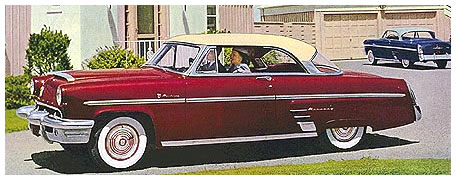 The year 1953 was a landmark for the Mercury Division of the Ford Motor Co. As one would expect, they did continue to share basic body parts, it only makes economic sense, and however, Mercury did have a couple of things that Ford didn’t:
The year 1953 was a landmark for the Mercury Division of the Ford Motor Co. As one would expect, they did continue to share basic body parts, it only makes economic sense, and however, Mercury did have a couple of things that Ford didn’t:
- A 118-inch wheelbase (three inches longer than its Ford counterparts)
- A new series called the Monterey – available in two- and four-door hardtop versions, as well as a convertible; a wagon was added later
- Also a second series – a two-model Custom lineup, two-door and four-door hardtop sedans
In reality, this was quite a change for Mercury as this was the first time it was marketing its own lines outright. Coming out of the doldrums of the late 1940s only to find itself fighting another war in the early 1950s, it made economic sense for Lincoln to keep the Mercury brand as a subseries, but 1953 was the breakthrough year.
The base powerplant was still the six-cylinder L-6 that was in the 200-cubic-inch range while the other powerplant available was the standby Ford flathead V-8. By 1953, though, Mercury had bumped the V-8s compression so it was able to offer a good 125 horsepower, while keeping the form factor the same.
(The real change came in 1954 when the entire engine line changed to the Y-block Ford V-8, or Ford’s basic short-block version of the engine that would be bored and stroked during the Pony Car wars a decade or so later.)
If there ever was a vehicle that seemed like a tank on wheels, the 1953 Merc had to be that vehicle. It had a large wheelbase and used the construction technique common at the time, frame-on-ladder, where the sub-frame was a steel oblong welded at the corners and that maintained its integrity by using welded cross-members. Everything was either welded to the frame or bolted or riveted to it with the final piece being the body.
This made for heavy cars – a hallmark of the mid-1950s Mercury – and reasonable performance as Mercury became its own line. The best was to come later in the 1950s.
The signature series was the Monterey whose show-stopping good looks began at the front end and swept through the body.
The front end featured a signature chromed grille and two large bumper pieces that extended above the bumper and made a design statement. Although the hood looked was long and straight, it was deceptive if you look closely at the hoodline you can see a gentle upslope toward the base of windshield that carried through the windshield. The windshield was rounded and extended into the gently sloping roofline and on through a sloping rear window and on through a long trunk. It was a very nice design for the time. The sides were straight with few design frills.
The interior retained its signature single half-moon gauge cluster surrounded by two rather large, almost airplane-like levers that controlled heat and ventilation and the like. This was retained from the 1952 interior.
